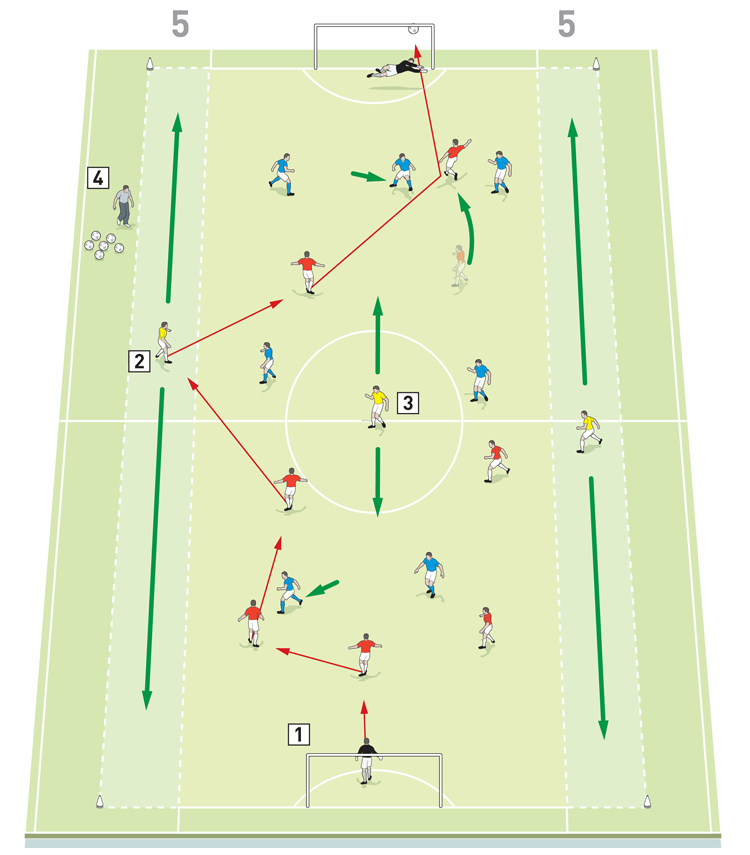




OUR BEST EVER OFFER - SAVE £100/$100
JOIN THE WORLD'S LEADING PROFESSIONAL DEVELOPMENT PROGRAMME
- 12 months membership of Elite Soccer
- Print copy of Elite Player & Coach Development
- Print copy of The Training Ground
You are viewing 1 of your 1 free articles
Defensive principles
All basic defending principles can be developed and practised with this session, particularly holding up attacks, pushing up from the back, covering over and getting out quickly to meet the wingers.
| Area | Up to two thirds of pitch |
| Equipment | Balls, bibs, cones, 2 full size goals |
| No. of Players | Up to 20 players + 2 goalkeepers |
| Session Time | Total: 55mins, 3v2 practice: 20mins, Round & round: 35mins |
This session can be used for working on both attacking and defending principles, but here I am focusing on the defensive side of the activities. All basic defending principles can be developed and practised with this session, particularly holding up attacks, pushing up from the back, covering over, getting out quickly to meet the wingers, tracking midfield runs into the box, blocking shots and crosses, and being aware of counter-attacks.
What do I get the players to do?
3v2 practice
We set up an area of 25-30 yards wide and 40 yards long, with a full size goal at one end. The players are split into pairs of defenders, with attackers in groups of three and two goalkeepers. We start with three attackers at one end ready to attack two waiting defenders in front of the goal, as shown [1].
One of the attackers starts play by passing to the first pair of defenders. The ball is passed back to one of the attackers, who become live when the defender touches the ball. The attacker who receives the ball back must pass it to a team mate before they can attack the defenders in a 3v2 with the aim of scoring past the keeper in the goal.
After three or four attacks, change the defending pair and switch goalkeepers. The attacking trio change after every wave.
1

2. The defender returns the ball to an attacker, who must pass to a team mate before attacking the goal in a 3v2
3. Defenders should try to hold up the attackers and stop them scoring
4. Rotate defenders and switch keepers every 3 or 4 attacks
5. Rotate strikers for every attack
What are the key things to look out for?
We want to see players are capable of holding up attacks and that they can resist making the first move until it is necessary to block a shot. They should also stay on their feet.
Defenders must keep the attackers going away from goal and making the only possible shot a ball struck towards the near post, which would favour the keeper.
Defenders should push out together when the ball is cut back in the box and not crossover to expose the third attacker.
We look for the goalkeeper to be quick off his line if needed, coming out as a sweeper to cover any through balls.
What do I get the players to do next?
Round & round
We set up a playing area of 70x54-yards, or between the two penalty boxes, with an additional five-yard wide channel on each side of the main area, as shown [2]. We have a goal and a goalkeeper at each end and split the players into two teams of seven outfield players and three neutrals, who play for the team in possession.
Two of the neutrals are locked into the unopposed wide channels, one in each, and they can only receive the ball in the attacking half of the team in possession. They can also only receive the ball from attackers or midfielders, not from the three defenders. The third neutral operates in the main area as a central midfielder but is limited to two touches and cannot score a goal.
Keepers can only distribute the ball with their hands; they cannot kick it unless it has gone dead.
With the exception of the outlined conditions, it’s a normal game, with the neutral players giving an overload to the attacking team.
Play starts with the coach feeding the ball into the 3v2 in midfield (the neutral midfielder giving the overload), or with a ball played directly to one of the strikers. The coach can keep attacks going and maintain the intensity by passing in another ball when it goes out of play. The coach may also want to prevent the attacking team’s defenders from crossing the halfway line in order to concentrate on making it a 5v6 in the attacking half.
Forwards should be encouraged to pressure the defenders at all times.
2

2. The yellow wingers in the wide channels play for the team in possession. They can only receive the ball when in the attacking half.
3. They cannot receive from the three defenders
4. The yellow midfielder is also neutral and plays for the team in possession. He is limited to two touches and cannot score a goal
5. The coach keeps up the intensity of attacks by passing in another ball when it goes out of play
What are the key things to look out for?
We look for the two central midfielders to screen the ball up to the centre forwards, staying together but not too flat. The same applies to the centre forwards, who need to prevent passes into the midfield and should force the possession team’s defenders to play square passes across the back.
We want to see the wider of the three defenders choosing the correct moment to confront the opposition winger and attempt to block crosses, or to force the winger to play back into midfield. The two remaining defenders should push across to cover the space in behind and aim to mark the two opposition centre forwards.
We want to see the central midfield pair drop back to support their three-man defence, especially covering the space in the penalty area where a cross could be cut back.
After a cross is cleared, the defenders should push out and must immediately exercise renewed pressure on the attacking team.
Related Files
Editor's Picks
Attacking transitions
Deep runs in the final third
Using the goalkeeper in build-up play
Intensive boxes drill with goals
Penetrating the final third
Creating and finishing
My philosophy
Pressing initiation
Compact team movement
Coaches' Testimonials

Alan Pardew

Arsène Wenger

Brendan Rodgers

Carlos Carvalhal

José Mourinho

Jürgen Klopp

Pep Guardiola

Roy Hodgson

Sir Alex Ferguson

Steven Gerrard
Coaches' Testimonials

Gerald Kearney, Downtown Las Vegas Soccer Club

Paul Butler, Florida, USA

Rick Shields, Springboro, USA

Tony Green, Pierrefonds Titans, Quebec, Canada
Join the world's leading coaches and managers and discover for yourself one of the best kept secrets in coaching. No other training tool on the planet is written or read by the calibre of names you’ll find in Elite Soccer.
In a recent survey 92% of subscribers said Elite Soccer makes them more confident, 89% said it makes them a more effective coach and 91% said it makes them more inspired.
Get Monthly Inspiration
All the latest techniques and approaches
Since 2010 Elite Soccer has given subscribers exclusive insight into the training ground practices of the world’s best coaches. Published in partnership with the League Managers Association we have unparalleled access to the leading lights in the English leagues, as well as a host of international managers.
Elite Soccer exclusively features sessions written by the coaches themselves. There are no observed sessions and no sessions “in the style of”, just first-hand advice delivered direct to you from the coach.







